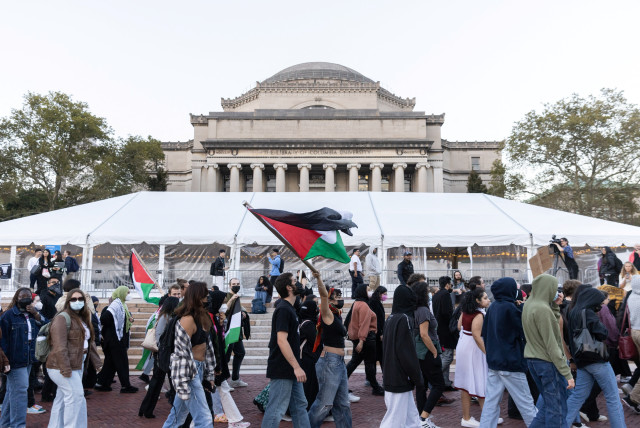To be Jewish on a college campus where students support Hamas - opinion

My own Columbia classmates have responded to the horror by posting comments supporting Hamas and trying to silence others.
I exist within two spheres as a religious Jewish student at a secular college. Externally, I blend in seamlessly; I complain about my professors, work in the library for countless hours, and eat my meals in the dining hall. However, internally, I carry a profound feeling of separateness, as though a gulf exists between me and my non-Jewish peers, rendering me self-conscious.
My feeling of otherness comes from feeling a lack of safety. To be Jewish is to carry the weight of history, to dread a repetition of our ancestors’ plight, when friends would look away during attempts to annihilate us. Still, until a few days ago, such a scenario in the 21st century seemed highly implausible to me. Deep down, I actually believed that the 2,000-year-old cycle of antisemitism had been replaced by genuine support and acceptance, that the world had truly decided “Never Again.”
Support for Hamas at Columbia University
The response of those around me to the brutal assault by Hamas against Israel on October 7th has shattered this view. It was the most deadly attack on Jews since the Holocaust. Every single Jew on Columbia’s campus has been directly affected. Each one of us knows someone – a family member, a close friend, or a friend of a friend – in a bomb shelter, on the front lines, or murdered either in the attack or in the fighting that ensued. Plain and simple: Hamas committed intentional, brutal violence against innocent civilians, the very definition of terror.
Yet my own Columbia classmates have responded to the horror by posting comments supporting Hamas – the organization whose official charter calls for the complete destruction of Israel and the annihilation of the Jewish people.
Furthermore, these students who condone the murder of Jews are not satisfied to make their voices heard; they also try to silence others. For example, Columbia’s Students for Justice in Palestine (SJP) condemned Dean Lisa Rosen-Metsch’s email to students lamenting the “terrible deadly terrorist acts of this weekend in Israel.” In response, SJP students claimed that she “obfuscated Palestinian resistance as ‘terrorism.’”
Reading those words, I felt physically sick. How could anyone refer to Hamas as a Palestinian resistance movement? Since when is the gunning down of hundreds of innocent young people at a music festival for peace a form of Palestinian resistance? Since when is beheading dozen of babies Palestinian resistance? Since when is taking a Holocaust survivor hostage Palestinian resistance?
What could lead people to be so morally blind? To view these attacks as anything but an unspeakable horror? Support for Hamas means endorsing the murder of innocent civilians based solely on their nationality and/or religion. Are Jews somehow deemed sub-human? Have we still not absorbed the vital lessons of history?
Let me be clear: Empathizing with the Jewish people does not diminish the plight of innocent Palestinians who have also lost their lives in the Israeli-Palestinian conflict. Every lost life is a tragedy – a fact that should resonate with each and every human being.
We, as Jews, feel alone. Our non-Jewish peers leave us to bleed by ourselves. They leave us to comfort each other while we are each battling our own sorrow. We wait for them to reach out, to ensure we are still standing, but it never happens. We wonder if they even care. As the world stands idly by and watches the Jews suffer, yet again, they betray the very essence of human empathy. The Jews are being annihilated once again, and the world is silent.
Your silence is deafening.
The writer is a sophomore at the joint program of the Jewish Theological Seminary and Columbia University’s School of General Studies.
Jerusalem Post Store
`; document.getElementById("linkPremium").innerHTML = cont; var divWithLink = document.getElementById("premium-link"); if (divWithLink !== null && divWithLink !== 'undefined') { divWithLink.style.border = "solid 1px #cb0f3e"; divWithLink.style.textAlign = "center"; divWithLink.style.marginBottom = "15px"; divWithLink.style.marginTop = "15px"; divWithLink.style.width = "100%"; divWithLink.style.backgroundColor = "#122952"; divWithLink.style.color = "#ffffff"; divWithLink.style.lineHeight = "1.5"; } } (function (v, i) { });

